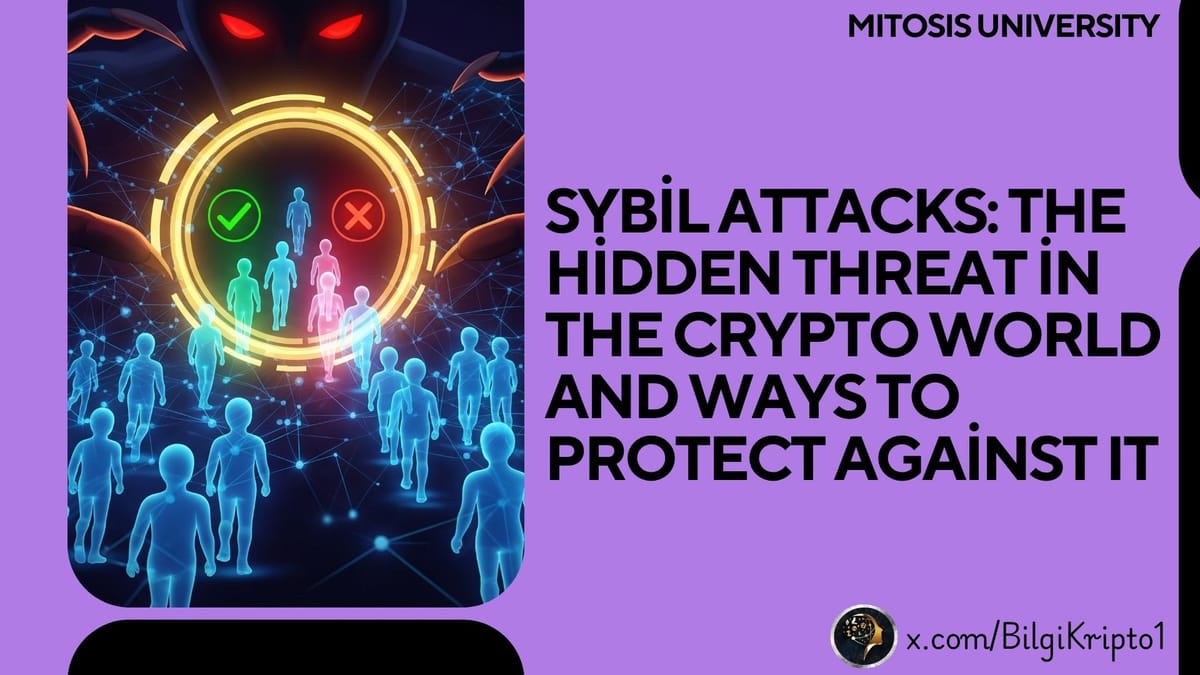Sybil Attacks: The Hidden Threat in the Crypto World and Ways to Protect Against It

In today's digital world, online systems and blockchain networks are becoming increasingly important. However, these systems are also vulnerable to attacks by malicious actors. One of these threats is the Sybil attack. So, what is a Sybil attack, how does it occur, and how does it affect blockchain networks? In this article, we will examine in detail what a Sybil attack is, the problems it causes, and how blockchains protect themselves against such attacks.
What is a Sybil Attack?
A Sybil attack occurs when a person or malicious actor tries to take over a network by creating many fake identities (accounts, nodes, or computers) instead of a single identity. Simply put, it is when the same person or entity acts as multiple fake users.
For example, a person creating dozens of fake accounts on social media platforms is one of the simplest examples. However, the situation is more complex in the crypto and blockchain world. Here, an attacker might run thousands of fake “nodes” on a blockchain network to manipulate the network.
Origin of the Term Sybil
The term “Sybil” is inspired by a case of “Dissociative Identity Disorder,” commonly known as “Multiple Personality Disorder.” The name comes from a woman known as Sybil Dorsett who suffered from this disorder. In computer science, this term was adopted to describe the phenomenon of multiplying fake identities in a network.

Problems Caused by Sybil Attacks in Blockchain and Other Networks
At its core, Sybil attacks aim to gain control over a network. When a large number of fake identities are created, these fake nodes can outnumber honest users and affect the network. The main issues caused by this are:
- Manipulation of Voting Mechanisms: In blockchain networks, some decisions are made through a voting system. By creating many fake identities, an attacker can gain a majority vote and control the network according to their interests.
- Blocking Block Confirmations: Fake nodes can block the network, preventing the formation or propagation of new blocks.
- 51% Attack: If an attacker controls more than 51% of the network’s computing power or “hash rate,” they can alter transactions on the chain, perform double-spending, or block other transactions. This type of attack is highly feared in the crypto world.
Example Explanation
Suppose a blockchain network consists of 1,000 nodes, each with equal voting rights. If a malicious actor creates 600 fake nodes, they gain control of the network. The votes and verification rights of other users become completely ineffective. This can be used to manipulate the network, perform fake transactions, or block transactions.
How Do Blockchains Prevent Sybil Attacks?
Although it is difficult to completely prevent Sybil attacks, blockchain networks develop various methods to make these attacks harder and costly. At the core of these methods are consensus algorithms. The most common ones are:
Proof of Work (PoW)
Used in large networks like Bitcoin, this method requires high computational power to create a block. It is practically very costly and almost impossible for an attacker to create thousands of fake nodes each with sufficient computational power.
Miners spend intense computational power to create blocks, and this energy cost prevents malicious attacks. For example, Bitcoin mining is not a simple process where you just turn on your computer and create a block; it requires massive energy and hardware.
Proof of Stake (PoS)
Here, those who want to control the network must invest a large amount of cryptocurrency. Creating fake identities is easy, but these identities must hold a significant stake. This creates a major economic barrier.
Delegated Proof of Stake (DPoS)
In this method, network users elect trusted representatives (delegates). If delegates behave maliciously while managing the network, users can replace them. This mechanism also helps prevent Sybil attacks.
Why Can’t Sybil Attacks Be Completely Prevented?
Sybil attacks are a complex problem that has been studied in computer science for many years and still lacks a definitive solution. Although blockchains make attacks harder with the algorithms mentioned above, complete prevention is not possible.
Especially in decentralized, open systems, new nodes can easily join the network. This allows malicious actors to continuously create fake identities.
Scientists try to reduce the impact of attacks with social verification, economic incentives, and algorithmic barriers. However, a fully protective method has yet to be developed.

Recent Examples and Threats of Sybil Attacks
Some concrete examples help to understand Sybil attacks better:
- 51% Attack in Cryptocurrency Mining: Networks like Ethereum Classic have witnessed attackers controlling a large portion of mining power to manipulate the network. This event involved a combination of fake nodes and hash power.
- Social Media Manipulation: Creating thousands of fake accounts on platforms like Twitter and Facebook to run campaigns can be seen as the social media version of a Sybil attack.
- DAO Attack (Decentralized Autonomous Organization): In 2016, an attacker gained excessive influence on the DAO project by acquiring extra tokens. This is also a similar type of Sybil attack.
Individual and Community Measures Against Sybil Attacks
- Node Verification: Verifying new nodes joining the network can reduce the number of fake nodes.
- Economic Incentives: Making it costly to set up fake nodes deters attackers.
- Community Monitoring: Users and developers can monitor unusual activities and report suspicious behavior in the network.
- Advanced Consensus Mechanisms: New algorithms like Proof of Authority and Proof of History are being researched and implemented.
Conclusion: Sybil Attacks and Security in the Crypto World
Sybil attacks pose a serious threat, especially to decentralized networks. Malicious actors attempting to take control of the network with fake identities can jeopardize transaction security and put users’ assets at risk.
However, consensus algorithms, economic barriers, and user oversight used in blockchain technology significantly reduce the impact of such attacks. Still, a completely secure environment in the crypto world has not yet been achieved, and research continues.
When investing in crypto and using networks, it is always essential to choose reliable projects, closely follow network activities, and stay informed. With the precautions taken against Sybil attacks, it will be possible to create stronger and safer blockchains



Comments ()